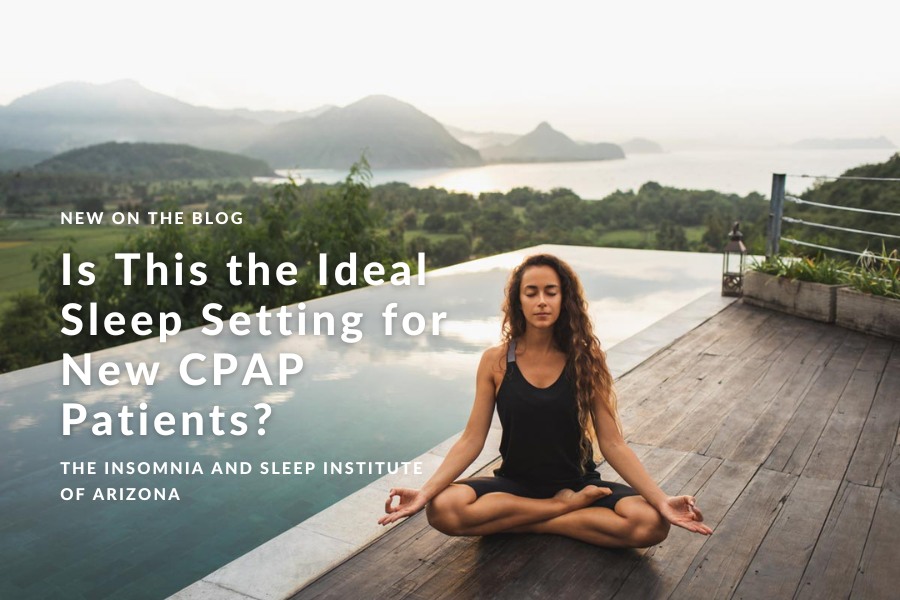Getting the correct diagnosis for obstructive sleep apnea (OSA) is just one potential challenge—and a reason you should visit The Insomnia and Sleep Institute of Arizona for all of your sleep disorder concerns. During your very first appointment you will meet with a sleep expert who can diagnose disorders. However, CPAP adherence is also a challenge for many, and a must if you want your insurance policy to cover treatment. Adherence is typically defined as using the CPAP machine for at least four hours each night. There are many factors that go into Phoenix CPAP adherence, but one is making sure you get the right machine, accessories, and have your mask optimally set up.
A recent study considered case reports and found an interesting “CPAP mask algorithm adjustment” that might just make getting used to your new CPAP easier. According to experiments, the “full-face” CPAP mask setting works very well for patients who also use nasal pillow masks. The physician behind the study theorizes that since mask algorithms are inherently built into CPAP devices, they give more inspiratory pressure for those specialized pillows. This is to compensate for more resistance that is prevalent in smaller cushions. Thus, using the full-face setting increases both comfort and CPAP adherence. “The full-face setting has been unanimous so far. We haven’t had anyone who thought the nasal pillow setting was uncomfortable,” reports the author.
A Look at One Popular CPAP Technology
Philips’ System One Resistance Control offers full system integration so that both the machine and mask work at ideal levels together. The initial technology of Philips Respironics debuted in 2009 with the System One system, which led to the Dreamstation and Dreamstation 2. Philips is one of the most popular CPAP brands, largely due to its smart technology. It “tells” the system to compensate for different resistance characteristics of the mask. According to a spokesperson, “With synchronous pressure delivery for every mask, patients can enjoy the full benefits of Flex comfort technologies no matter which mask is used.”
One CPAP manufacturing worker, who requested anonymity, comments that a full-face mask naturally doesn’t have a lot of resistance while the nasal mask offers some—but stresses that the nasal pillow has the most. They also pointed out that resistance is going to negatively affect the overall pressure profile if there is not a pressure adjustment made. However, the research behind the study believes that pressure compensation algorithms make nasal pillow masks more difficult to manage. This was the basis for the researcher’s case study report.
An Informal Approach
The case study began when a group of patients and staff at a sleep center tested nasal pillow mask usage on the nasal pillow mask setting—then changed to the full-face mask setting. Every participant in this informal study said the full-face setting was the best. Each of the participants were also “CPAP-naïve” and new to using the systems. It is possible that they may change preference as they get used to CPAP therapy, but changing and evolving your CPAP therapy is always an option for everyone. It takes some time to get used to the pressure and flow of CPAP therapy. Currently, a formal trial is being created and awaits approval from the Institutional Review Board.
Some wonder if using a different setting might interfere with how well CPAP therapy works, but the researcher is adamant that it will not. He is not alone. There is a growing group of sleep experts who think the industry doesn’t take on therapy correctly—in fact, he argues that in some cases CPAP therapy is “backward.” He points to evidence that expiratory pressure is the essential component for good CPAP therapy rather than inspiratory pressure. The initial case studies are prompting others to think about how CPAP is approached. One sleep specialist said, “When we heard about this, we were all just kind of looking around like, ‘that explains a lot in terms of what our patients experience and why they’re experiencing it’.”
If you are ready to see a sleep specialist about a potential OSA diagnosis, or if you already have a diagnosis and need help with CPAP therapy, work with the leading experts in sleep medicine. Contact The Insomnia and Sleep Institute to schedule your consultation by calling the office or completing the online contact form now.





